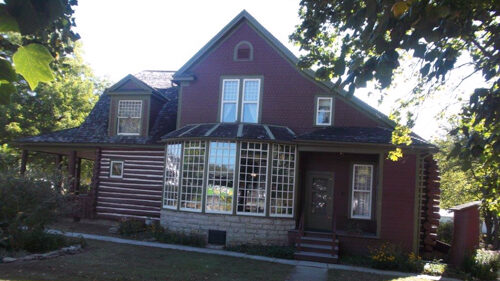The Limberlost Cabin, Amish Country, and Berne
Tuesday, September 6, 2013
By Nelson Price
In a sequel to the previous year’s pilgrimage to Wildflower Woods in Rome City, the Society of Indiana Pioneers visited the Limberlost Cabin, beloved by internationally famous author, photographer, and naturalist Gene Stratton-Porter, during the Fall Pilgrimage. Actually, the journey was more of a prequel because Limberlost – located near Geneva in northeastern Indiana – was her original home; Wildflower Woods was built later.
So, the Pioneers visited the two Indiana State Historic sites associated with Gene Stratton-Porter (1863-1924) in reverse order. Because of new developments at Limberlost and the nearby Loblolly Marsh and Limberlost Swamp – recently dedicated as an Indiana nature preserve – it was timely to make the trips in that sequence.
Limberlost Cabin was just one of several highlights during the trip on Sept. 6, which was sunny and beautiful. The Pioneers also visited an Amish home, an Amish school (a truly rare opportunity), and a new Glockenspiel in the historic town of Berne. The trip also included a catered dinner underneath the last covered bridge built over the Wabash River.
With about 42 people aboard, the Pioneers’ motor coach embarked from Indianapolis pickup sites to Adams County, home of both Geneva and Berne. About 12 percent of Adams County is Amish, the group was told. Pioneers received a background presentation about protocol in dealing with the region’s Amish at the first destination, a new, impressive visitors center at the Limberlost site. The nearby wetlands inspired Gene Stratton-Porter and served as the basis for many of her 13 bestsellers, including her masterpiece “A Girl of the Limberlost” (1909).

The Pioneers toured the Amish school after stopping at the visitors’ center. It’s a one-room schoolhouse attended by about 35 children ranging in age from six years old to 15 or 16. Under the direction of their teacher, the children greeted the Pioneers with a song written for the occasion and then responded to questions from the group. Amish children end their schooling in the eighth grade, even if they attend public schools, as some families choose to do. In Adams County, though, most Amish families send their children to private schools like the one visited by the Pioneers.

A trip to an Amish home followed that visit, the house of a midwife. She allowed the group to tour her birthing room and cheerfully answered questions. Indiana now has the third largest population of Amish (about 48,000 residents) in the country, after Ohio and Pennsylvania.
The next destination was the town of Berne, where the Pioneers enjoyed a buffet luncheon at the Palmer House restaurant. During the luncheon, the Pioneers were greeted by the mayor of Berne and other civic leaders.
Then, the Pioneers visited Berne’s clock tower, the Glockenspiel. It opened in 2010 on an outdoor plaza after the residents of Berne raised $3.5 million. Modeled after a Glockenspiel in Bern, Switzerland, the ancestral home of the immigrants who founded Berne, the clock tower is 160 feet tall.

The Pioneers enjoyed a presentation by Mike Schwartz, the local contractor who designed and built the clock tower. Its mechanical figures tell the history of the Indiana town as they rotate. The figures include a sailing ship from Europe, a farmer, a woodworker, and a Berne bear, the high school basketball team’s mascot.

The Pioneers returned to the Limberlost Cabin to tour the 14-room home, where Gene Stratton-Porter lived until 1913. Many rooms display her pioneering photographs of birds, other wildlife, and the region’s natural beauty. Site manager Randy Lehman explained how she nursed injured birds back to health inside the cabin. The home includes a music room; Gene Stratton-Porter, in addition to being a talented writer and photographer, was a skilled pianist and played several other instruments.

In the visitors center, the Pioneers enjoyed a presentation by local naturalist Ken Brunswick, who was a key figure in reclaiming 1,600 acres of the Limberlost Swamp and Loblolly Marsh. During Gene Stratton-Porter’s lifetime and for years afterward, the wetlands had been dredged in unsuccessful efforts to create farmland. The reclamation projects have involved planting 43,000 trees and removing primitive drains.
Then, the Pioneers got to see some of the results first-hand. The group traveled to Limberlost Swamp and Loblolly Marsh, where many disembarked for a fascinating nature walk. Since the swamp and marsh have been reclaimed, birds and wildlife that had been native to the region – and that were prevalent 100 years ago – have started to return. The area has become the home of Great Blue Herons, egrets, deer, wildflowers, and much more.
The Fall Pilgrimage ended with a treat. The Pioneers visited the Ceylon Covered Bridge, the last covered bridge built on the Wabash River in 1860. Located in an area known as Rainbow Bottom, the covered bridge has been extensively reconstructed at a cost of more than $300,000. The Pioneers ended the day with a light dinner on tables on the covered bridge.
